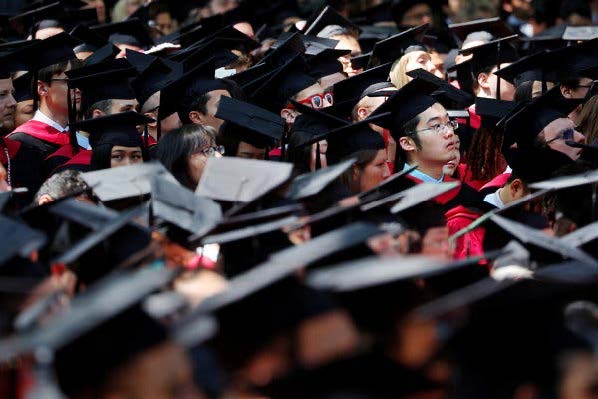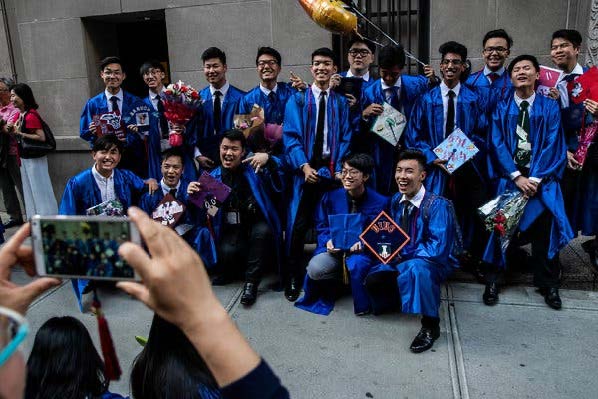
Harvard Is Wrong That Asians Have
Terrible Personalities
By Wesley Yang
Mr. Yang is a columnist at Tablet and the author of the forthcoming book “The Souls of Yellow Folk.”
June 25, 2018

Students at the Harvard University commencement in May. Brian Snyder/Reuters
There’s a moving passage contained in a deposition taken in the major class-action lawsuit accusing Harvard University of racial bias against Asian-Americans. An attorney for Students for Fair Admissions, the nonprofit group representing a dozen Asian-Americans denied admission by Harvard, confronts the assistant principal of Stuyvesant High School with evidence that white students applying to Harvard in 2014 from her school were more than twice as likely to be admitted to the university as were her Asian-American students.
The assistant principal, Casey Pedrick, starts to cry.
(Witness crying.)
Q. I’m sorry this is upsetting to you. Do you want to take a break?
A. (Witness shakes her head no.)
Q. You want to keep going? Do you want to tell me why this is so upsetting to you?
A. Because these numbers make it seem like there’s discrimination, and I love these kids, and I know how hard they work. So these just look like numbers to all you guys, but I see their faces. That last sentence is worth lingering on for a moment. When Ms. Pedrick looks in the faces of her Asian students, who comprise more than 70 percent of the population at Stuyvesant, she doesn’t see any one of them as “yet another textureless math grind,” as M.I.T.’s dean of admissions was brazen enough to call a Korean-American student to Daniel Golden, the author of “The Price of Admission.” She doesn’t see her students as an arrogant, privileged “ethnic group” who think they “own admission” to these high-performing schools, as the new chancellor of New York City Schools, Richard Carranza, recently put it.
Ms. Pedrick knows that her Asian students believe they have to earn their admission to Stuyvesant in the only way anyone has for more than four decades: by passing a rigorous entrance exam. Their parents will often invest a major share of the family income into test preparation courses to help them pass — this despite the fact that more Asians live in poverty than any other group in New York City.
At the time that she was deposed, Ms. Pedrick did not know that the Harvard admissions office consistently gave Asian-American applicants low personality ratings — the lowest assigned collectively to any racial group. She did not know that Harvard’s own Office of Institutional Research had found that if the university selected its students on academic criteria alone, the Asian share of the Harvard student body would leap from 19 percent to 43 percent. She did not know that though Asians were consistently the highest academically performing group among Harvard applicants, they earned admission at a rate lower than any other racial group between 2000 and 2019.
All she knew was what she had witnessed as an assistant principal and the single fact that she was shown by her deposers. But perhaps she intuited the rest.
Earlier this month, we learned that a review of more than 160,000 individual student files contained in six years of Harvard’s admissions data found that Asians outperformed all other racial groups on every measure of academic achievement: grades, SAT scores and the most AP exams passed. They had more extracurricular activities than their white counterparts. They wererated by interviewers who had met them as virtually on par with their white counterparts in their personal qualities. Yet Harvard admissions officers, many of whom had never met these applicants, scored them collectively as the worst of all groups in the one area — personality — that was subjective enough to be readily manipulable to serve Harvard’s institutional interests. The report by the plaintiff’s expert witness, the Duke University economist Peter Arcidiacono, revealed that Harvard evaluated applicants on the extent to which they possessed the following traits: likability, helpfulness, courage, kindness, positive personality, people like to be around them, the person is widely respected. Asian-Americans, who had the highest scores in both the academic and extracurricular ratings, lagged far behind all other racial groups in the degree to which they received high ratings on the personality score.
“Asian-American applicants receive a 2 or better on the personal score more than 20% of the time only in the top academic index decile. By contrast, white applicants receive a 2 or better on the personal score more than 20% of the time in the top six deciles,” wrote Mr. Arcidiacono.
“Hispanics receive such personal scores more than 20% of the time in the top seven deciles, and African Americans receive such scores more than 20% of the time in the top eight deciles.” Even if the very worst stereotypes about Asians were true on average, it beggars belief that one could arrive at divergences as dramatic as the ones Mr. Arcidiacono documents by means of unbiased evaluation.
The Asian-American population has more than doubled over the last 20 years, yet the Asian-American share in the student populations at Harvard has remained frozen. Harvard has maintained since the 1980s, when claims of anti-Asian discrimination in Ivy League admissions first surfaced, that there is no racial bias against Asian-Americans once you control the preferences offered to athletes and alumni.
The discovery process in this case has demonstrated that this claim is no longer supportable. Mr. Arcidiacono found that an otherwise identical applicant bearing an Asian-American male identity with a 25 percent chance of admission would have a 32 percent chance of admission if he were white, a 77 percent chance of admission if he were Hispanic, and a 95 percent chance of admission if he were black. A report from Harvard’s own Office of Institutional Research found that even after alumni and athletic preferences were factored in, Asians would be accepted at a rate of 26 percent, versus the 19 percent at which they were actually accepted. That report, commissioned back in 2013, was summarily filed away, with no further investigation or action taken.
No innocuous explanation can account for the extent of these disparities. Yet Harvard is insisting that those who call it what it plainly is — racial discrimination — are advancing a “divisive agenda.”
On June 12, Harvard’s president, Drew Gilpin Faust, sent an email to all alumni of the college warning of a forthcoming attempt to use “misleading, selectively presented data taken out of context” in order to “question the integrity of the undergraduate admissions process.” The statement promised to “react swiftly and thoughtfully to defend diversity as the source of our strength and our excellence — and to affirm the integrity of our admissions process.”
As the Harvard law professor Jeannie Suk Gersen pointed out in The New Yorker, the tortuous and evasive quality of the discussion of the treatment of Asian-Americans in elite colleges stems from the way our legal doctrine on affirmative action has evolved. The Supreme Court ruled that it was legal to use race as a criterion in admissions in order to pursue the educational benefits of “diversity” in the landmark 1978 case Regents of the University of California v. Bakke, but it forbade the imposition of racial quotas and, by extension, the maintenance of a policy that consciously aims at “racial balancing.”
This imposes a legal condition on Harvard. Rather than make the honest claim that it actively pursues racial balance and that there are good reasons to do so, the school must engage in a charade that nearly everyone working in the proximity of a highly competitive college knows to be false.
Harvard has been here before. “To prevent a dangerous increase in the proportion of Jews, I know at present only one way, which is at the same time straightforward and effective,” wrote A. Lawrence Lowell, Harvard’s president in the 1920s, “and that is a selection by a personal estimate of character on the part of the Admission authorities, based upon the probable value to the candidate, to the College and to the community of his admissions.” The opacity of its admissions procedure could veil what Lowell’s written correspondence would later disclose to be a fully intended policy of discrimination.
The same zealously defended discretion to rank applicants on intangible personality traits would, of course, later come to the aid of blacks, Hispanics and Asians when Harvard pivoted toward an embrace of affirmative action in the 1970s. Affirmative action and the privileges of legacy and wealthy students, most of whom are white, both found shelter in the concept of “diversity” — a term that refers at once to racial diversity and the mix of people that make Harvard’s student body so varied and so disproportionately rich. Alumni preference, so crucial to the sustenance of Harvard’s $37 billion endowment, could provide cover before the courts for racial bias. Harvard’s commitment to racial diversity could whitewash its devotion to the preservation of privilege before liberal public opinion.

Stuyvesant High School students celebrating their graduation on Thursday. Jeenah Moon for The New York Times
There is, in this fragile system, a place for textureless math grinds. But only a few.
The conclusion is unavoidable: In order to sustain this system, Harvard admissions systematically denigrated the highest achieving group of students in America. Asian-Americans have been collateral damage in the university’s quest to sustain its paradoxical mission to grow its $37 billion endowment and remain the world’s most exclusive institution — all while incessantly preaching egalitarian doctrines.
Until very recently, Asian-Americans have been politically quiescent and largely deferential to a status quo that works against them. But now, a portion of the Asian-American community is acting in what it deems to be its own interest.
In the face of this challenge, Harvard has resorted to the desperate expedient of promulgating racial stereotypes. In denying that it has engaged in racial balancing at the expense of Asian-Americans, Harvard has put itself in the morally untenable position of affirming a brazen falsehood.
Harvard’s lawyers will soon tell the highest court in the land that Casey Pedrick’s Asian students are less respected because they are less likable, less courageous, and less kind than all other applicants. The university has decided that this is necessary for the greater good. The reality is that it is a carefully considered act of slander.
 VIS 國際實驗教育 高中部/國中部/小學部 G05~G12
VIS 國際實驗教育 高中部/國中部/小學部 G05~G12
